Manage containers at the edge with Linux
Image by Ulrike Leone from Pixabay
Billions of people use online document editors like Google Docs or Microsoft 365 to write reports, collaborate on projects, and keep track of meeting notes. But there is a growing concern about Big Tech platforms having access to your content, tracking you across the web, and collecting data to train privacy-invading AI models.
Today we’re announcing a new end-to-end encrypted, collaborative document editor that puts your privacy first. Docs in Proton Drive are built on the same privacy and security principles as all our services, starting with end-to-end encryption. Docs let you collaborate in real time, leave comments, add photos, and store your files securely. Best of all, it’s all private — even keystrokes and cursor movements are encrypted.
Get started by creating a free Proton Drive account today (if you don’t already have one). We are rolling out Docs starting today, and the feature will be available to all users over the next couple of days.

Online document editors have become a core productivity tool, used for everything from private journals to sensitive business strategies. The problem is that most companies offering document editors today are the same Big Tech companies that collect and monetize your private information.
As a result, there are multiple significant issues:
When you write in a document, you would like to think your ideas are only for you and the people you choose to share with. But that’s not really the case.
We built docs in Proton Drive as a joint project with the team from Standard Notes, who share our core values around privacy and security.
As with all Proton services, Docs put you back in control of your data. Thanks to our open-source end-to-end encryption, you are the only one with the key to read and share your documents. Not even Proton can access your docs content or metadata (such as file names). Instead of storing your data in the US, where it can be subject to government surveillance, Proton is protected by strict Swiss privacy laws.
Docs are integrated into your Proton Drive, meaning you have a unified and secure space for your document management and storage. We designed Docs to be a clean, simple experience. With Docs you can:
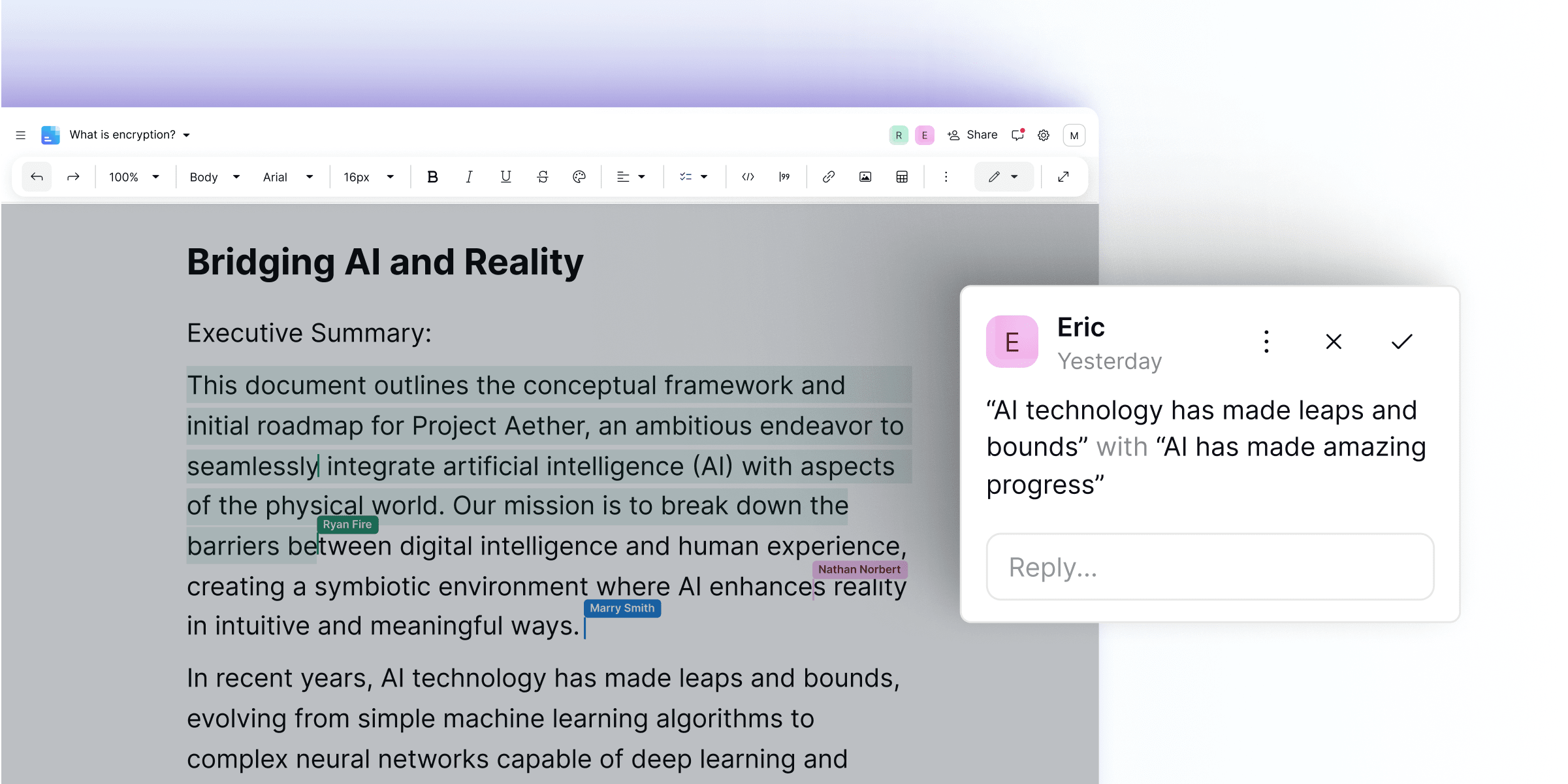
Far too often, online productivity suites require you to accept surveillance as a condition of use. Docs is a milestone in our journey to building a better internet where privacy is the default. It is the first collaborative document editor that combines open source end-to-end encryption within a secure ecosystem that includes email, cloud storage, calendar, and more, so you can break away from Big Tech services that exploit your data. This is another important step toward advancing the mission of the nonprofit Proton Foundation.
With Proton Drive and Docs, you now have a secure, privacy-first cloud storage and productivity alternative. If you’re working in law firms or healthcare, you can draft contracts and manage patient data in compliance with privacy laws. Journalists, content creators, and entrepreneurs can keep their projects protected from data leaks and Big Tech surveillance (no AI snooping on your work). Whether for work or for personal use, Proton Drive ensures your documents remain safe and private.
We’re excited to see how you will benefit from the robust privacy protections that Docs offer. Ready to get started? Check out Docs in Proton Drive and start collaborating privately.
To get the best experience in Docs, please be sure to update your Proton Drive app to the latest version on desktop and mobile.
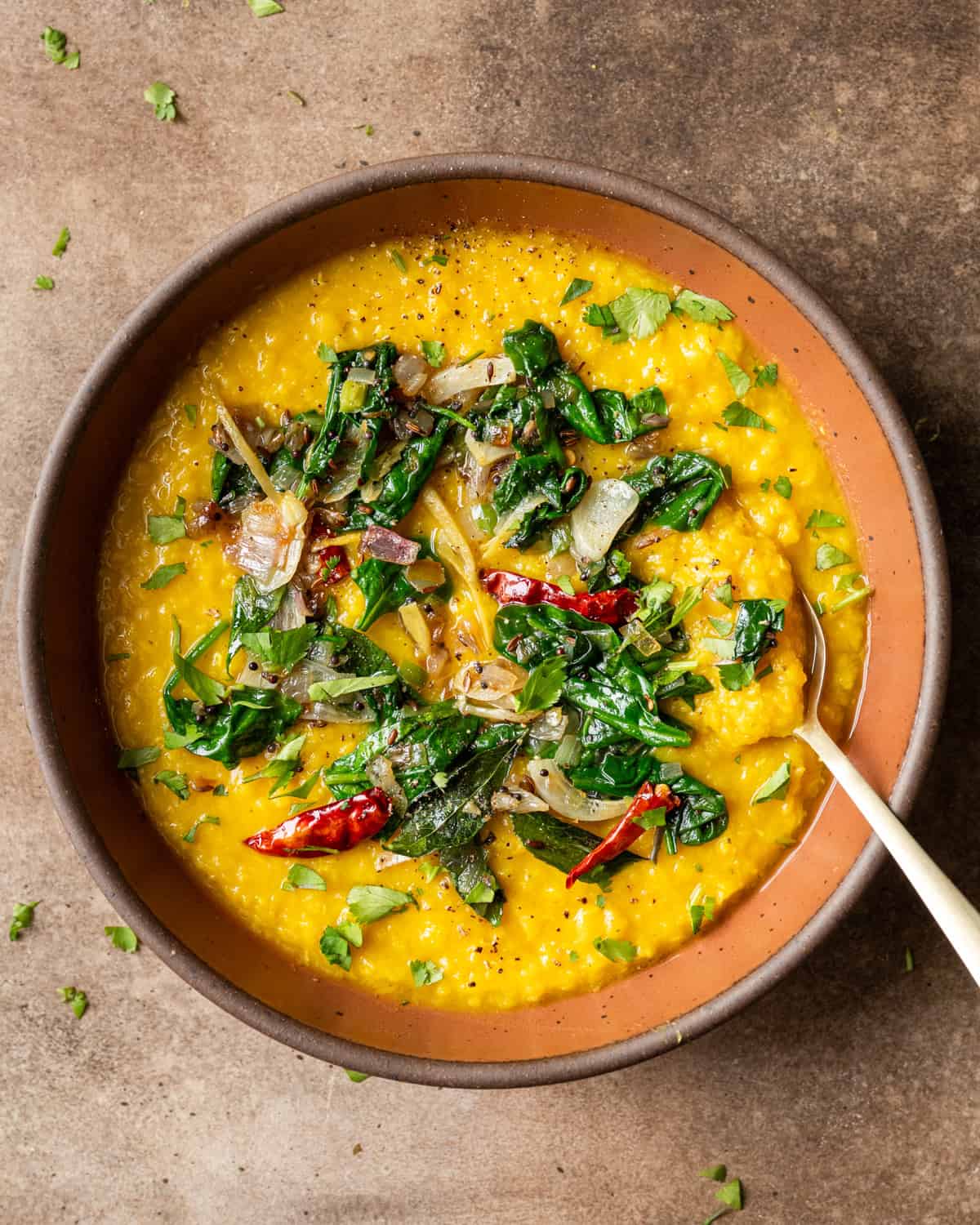
Do you always leave your favorite Indian restaurant wondering how they pack a million flavors into one dish? Here’s my go-to recipe for pulling that feat off with minimal fuss: Dal Palak. Serve it for a crowd, and you’ll quickly become your friend group’s default “let’s go to their house for dinner” person.
There are two parts to this comforting meal, though I promise it tastes like so much more. Step one: Make a super simple dal of creamy red lentils seasoned with turmeric, lemon juice, and salt—all you need is a saucepan and a whisk—and warm up some cooked rice from that big container in your fridge (you know the one).
Step two: Whip up the tadka, which is a mix of Indian spices and aromatics cooked in hot oil, as well as baby spinach wilted to silky perfection in this version. Before serving, pour the tadka over the dal and serve with rice.
Step three (bonus): Congratulate yourself for making a restaurant-level dinner and enjoy!!
Table of Contents:
1. What is dal palak?
2. Why this recipe works
3. Ingredient notes
4. Step by step instructions
5. Tips for making this recipe
6. Frequently Asked Questions
7. Recipe Card with Notes
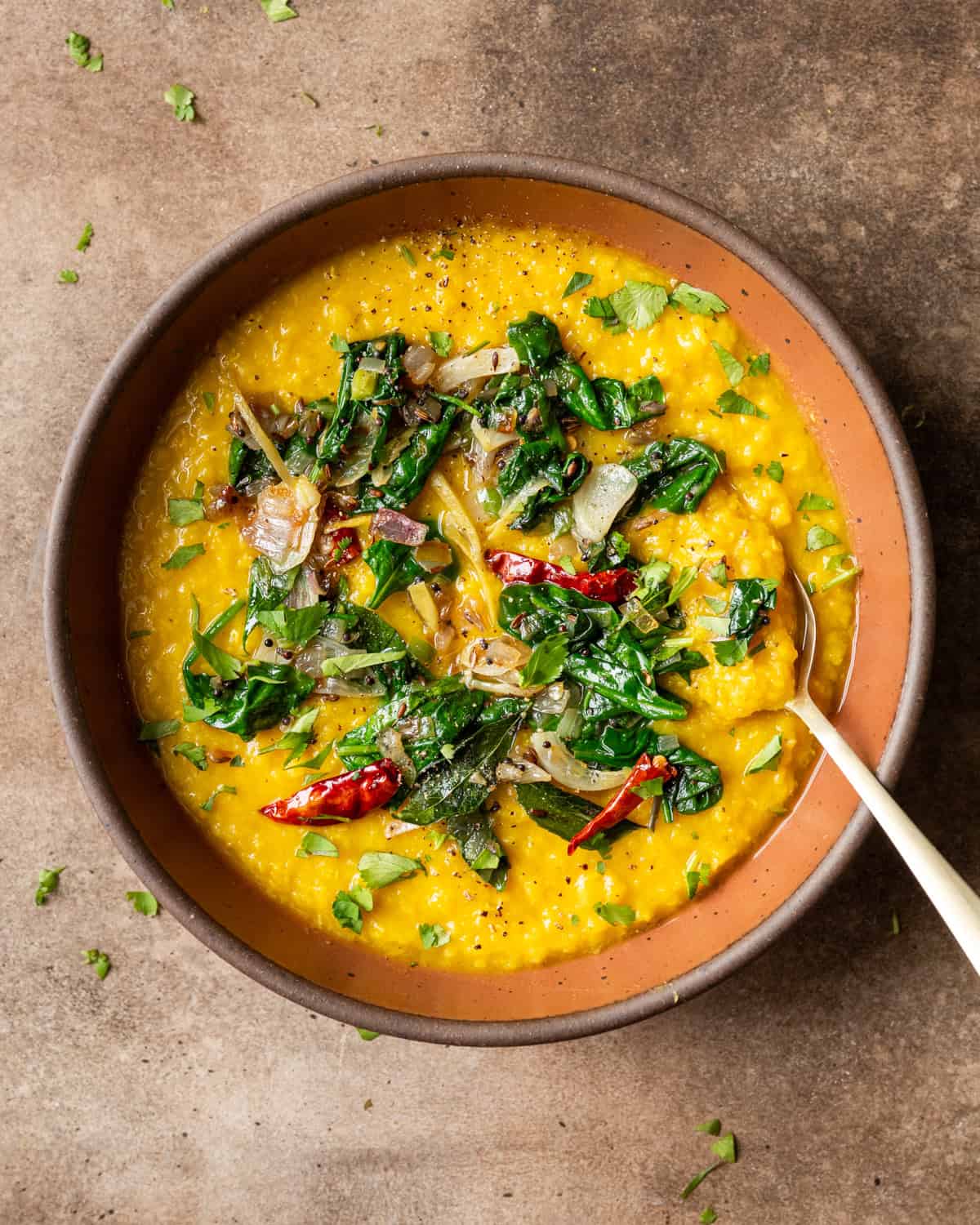
Dal palak, or spinach dal, is an Indian dish made with seasoned and aromatic lentils (dal) and spinach (palak). Not that this is all greens and no glory—the spinach gets seasoned with the best spices and aromatics in the game and becomes truly delicious.
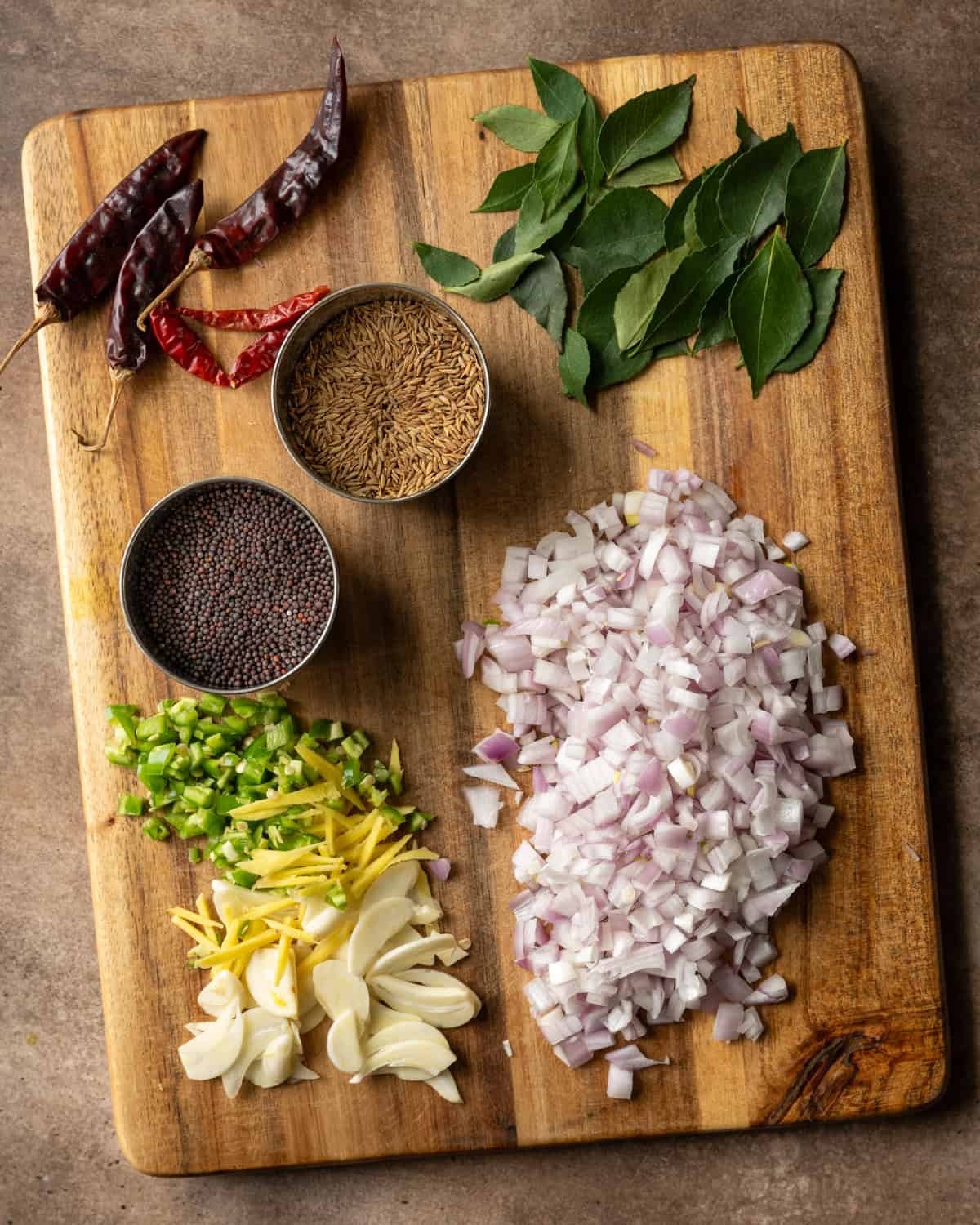
From the whole Indian spices bought alive on the stove to the best-in-class aromatics, there’s no shortage of rich and exciting Indian flavors in every bite of this dish.
It all starts with the lentils, which soften so much after just 20 to 30 minutes that you can whisk them into a puree. A small amount of turmeric gives the lentils a gorgeous golden color (and antioxidants!) while salt and lemon add flavor.
Once you’ve cooked your dal, you’ll add the spinach tadka on top. This might be the best way to use spinach (no disrespect to my Vegan Spinach Artichoke Dip)—it takes on crazy amounts of flavor and gets that totally luxurious, silky-smooth texture.
If you put on a blindfold and someone spoonfed you this dal palak (weird image but stick with me here), you’d taste pure comfort. But this dish is also incredibly wholesome.
Lentils are a great source of plant-based protein and fiber, so this dish keeps you full while benefiting your digestive system. The spinach adds a boost of anti-cancer antioxidants (those leaves are powerful!), vitamins A, C, and K, iron, and calcium. It’s a much more exciting way to get your daily nutrients than those chalky vitamins and supplements building dust in your cabinets.
I’m not saying this dal palak would slay at brunch (though I’m not not saying that), but I am saying it’s super simple to put together. Simmering lentils and whisking them into puree? A total breeze. Tossing whole spices in oil, adding aromatics you’ve lovingly chopped, and tenderly folding in the spinach? A cakewalk. Plus, it all goes over rice, which is the 101 of grains.
It all takes around 40 minutes from start to finish (prep included), so you’ll have a gourmet dinner with maximum payoff you can enjoy on a weeknight or for a dinner party with friends.
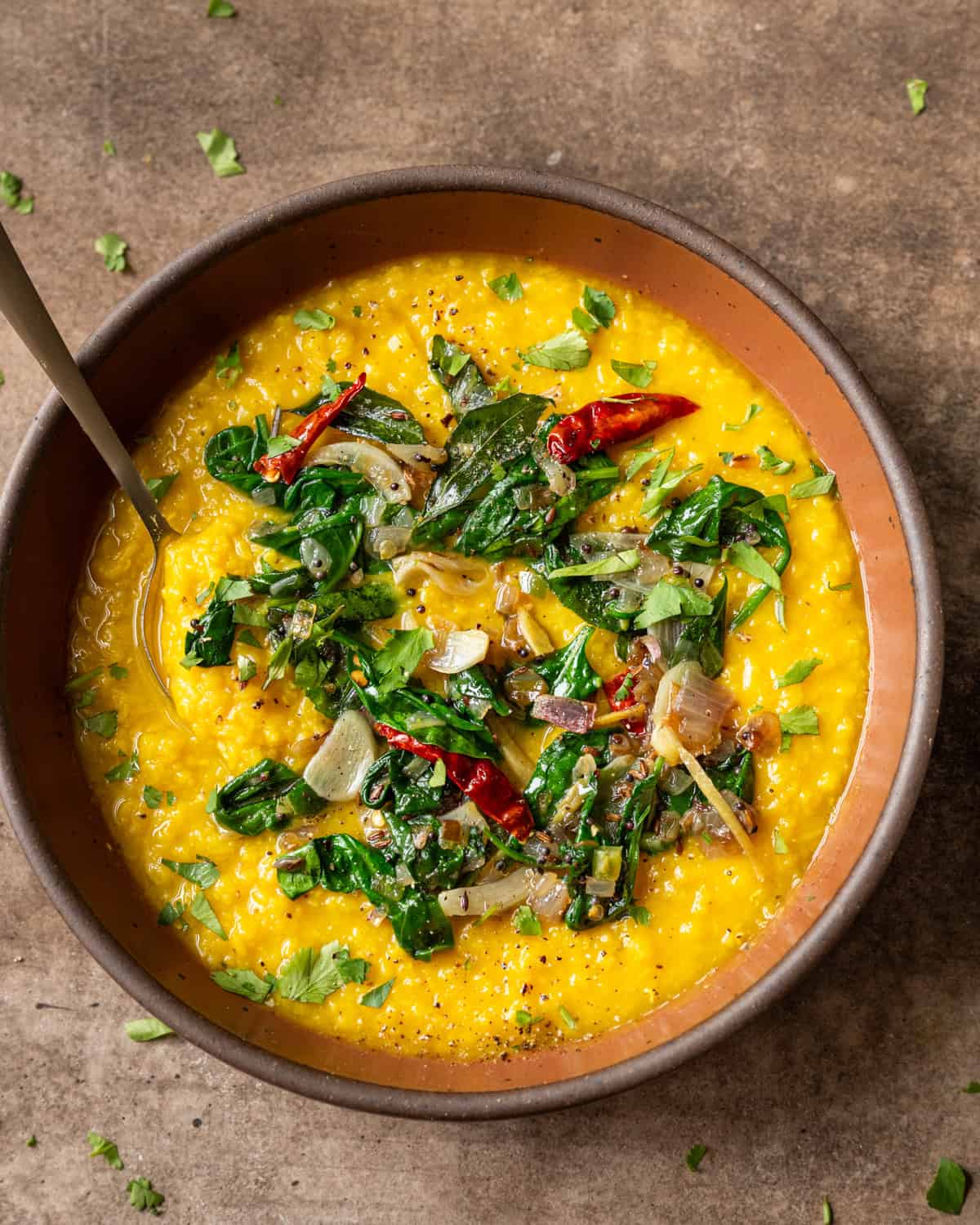
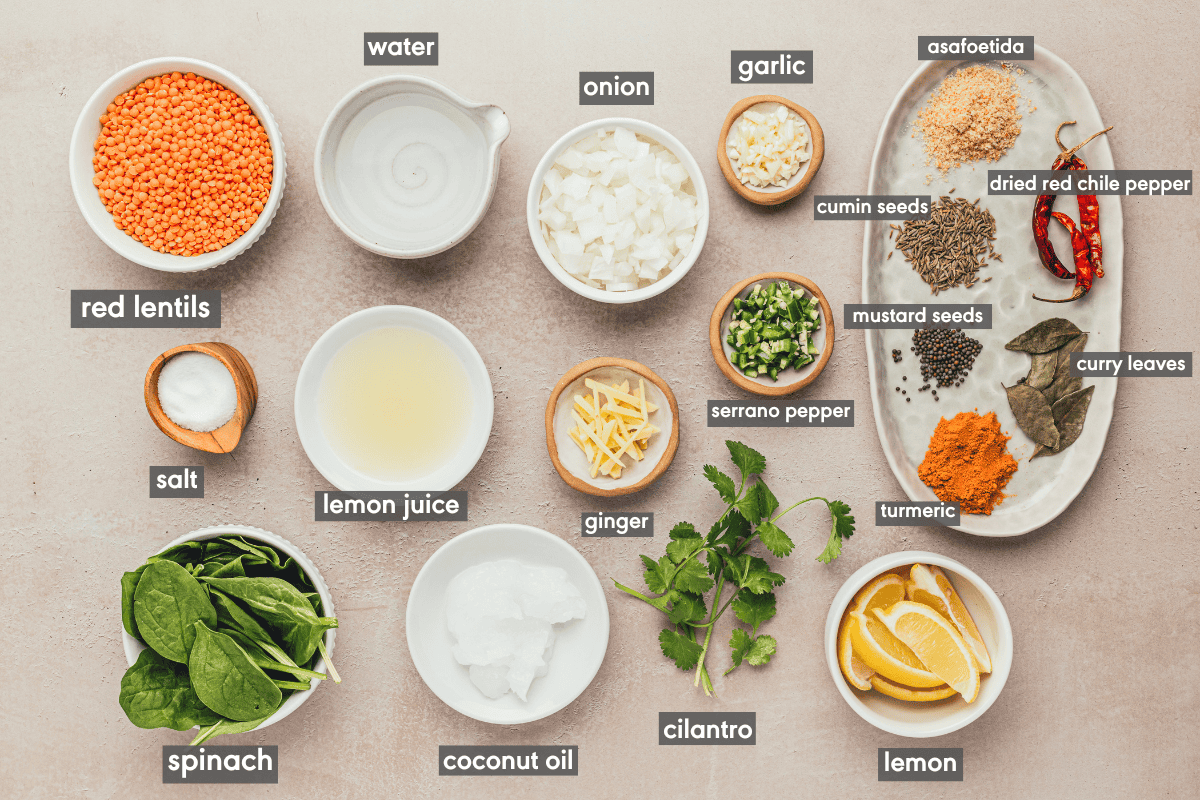
Many varieties of dal are made with split lentils, like red split lentils (masoor dal) or yellow split lentils (moong dal) because, when cooked, they become very soft and creamy. It’s like baby food if it were beautiful and delicious.
You can use regular red lentils for this recipe (sold at almost any grocery store), or if you’re making a trip to your local South Asian grocer for the spices, pick up some masoor dal, as these split red lentils cook a bit quicker.
This recipe also works great with moong dal (split yellow lentils).
I don’t recommend using green or brown lentils for this recipe because they don’t have the same melt-in-your-mouth texture when cooked.
A small amount of ground turmeric is stirred into the lentils as they cook to give them a golden color and a subtle warm flavor.
If you want to maximally absorb turmeric’s anti-inflammatory compound, curcumin, stir a pinch of ground black pepper into the simmering lentils when you add the turmeric. Black pepper contains piperine, which is the key that opens curcumin’s padlocked, steel-reinforced door.
The four core aromatics of Indian cooking (at least in my definition) impart incredible flavors that will delight your taste buds. Onion, garlic, ginger, and chile peppers lend a baseline of rich, savory, and spicy-ish flavors to this dal palak and plenty of other Indian dishes such as my Chickpea Curry.
Substitute: I use both fresh green chile peppers (serranos or jalapeños) and dried red chile peppers to give the tadka some heat. Fear not though, my Babymouths! You can remove the membranes and seeds from the fresh peppers, omit the dried red chile peppers, or leave out all the peppers (or give them to me because I use them in everything).
Although fresh curry leaves (no relation to curry powder, not even distant cousins) are optional in this dal recipe, their bright, citrusy, earthy, and complex flavor adds SO much to this dish.
They’re worth the run to your local Indian grocery store, which is probably full of other modestly priced kitchen staples too—dried chickpeas, kala namak (aka black salt, the star of my seriously amazing tofu scramble), giant containers of turmeric, the list goes on.
Tip: Can’t find fresh curry leaves? Try ordering dried curry leaves online (affiliate link). They’re not as pungent, so double the amount.
Store fresh curry leaves layered in paper towels in a ziploc bag in the crisper; they’ll stay green and gorgeous for at least two weeks. Freezing them instead? Don’t be alarmed if they lose some color—they’ll still taste delicious.
These aren’t the ground spices you buy in tiny little containers at your local supermarket. They’re the full seed, directly from the plant, and they’re packed with absolutely outrageous amounts of flavor.
I use black mustard seeds and cumin seeds—two more Indian grocery store highlights—in this dal palak. Let them sizzle in some hot oil for a bit, and once the mustard seeds start popping and the cumin seeds darken in color and become super fragrant, you know you’ve unlocked those next-level Indian flavors (and it’s also a sign that it’s time to add the next ingredient).
Where to buy: Your local Indian grocery store, but if not possible, buy them online. Well-stocked grocery stores will sell cumin seeds and, sometimes, yellow mustard seeds (not commonly used in Indian cooking but an acceptable substitute).
Substitute: Struggling to find whole mustard or cumin seeds? Customize the tadka with other whole spices. I have lots of ideas for you in the Tips section.
A little asafoetida goes a long way. Just a pinch in the tadka lends a quintessentially Indian flavor that sets this dish apart. It does smell very funky when you open the bottle, but the odor gets cooked off, and then you’ll get to know this powerful seasoning for who she really is: a not-at-all-smelly superstar.
Tip: To avoid the funky aroma from pervading your spice cabinet, don’t fully open your bottle of hing. Instead, take a knife or fork and poke just a tiny hole in the jar, if possible. And keep it sealed whenever you’re not using it!
Where to buy: Find asafoetida at your local Indian grocery store or buy it online (affiliate link)
Gluten-free? Skip the asafoetida. Most varieties contain small amounts of gluten.
Oh baby does the baby spinach in this tadka get silky and beautiful! Add it in batches and toss it with tongs so it wilts just enough to still hold up while getting coated in all those lovely Indian flavors. Serve it over the dal and you’re all set!
Substitute: Not a spinach stan? Just like in my Saag Aloo recipe, you can substitute the spinach for any leafy greens you like, such as baby kale or other tender greens that will cook quickly.
After rinsing the lentils, add to a saucepan, cover with water, and bring to a boil. Add the turmeric and partially cover; simmer until soft and tender.
Whisk the lentils vigorously until somewhat pureed.
Cook for a few minutes until completely mashed and thickened. Stir in salt and lemon juice to season.
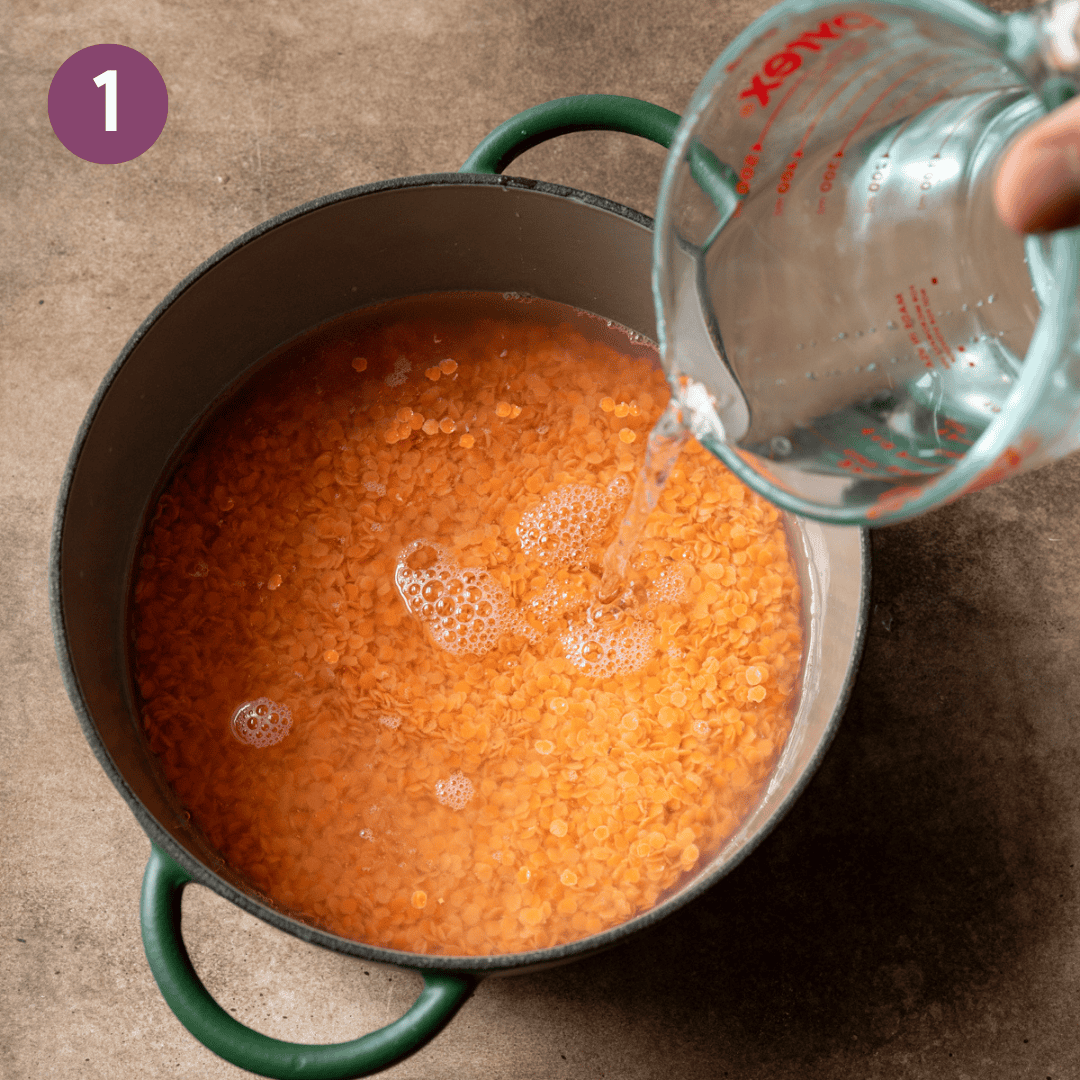

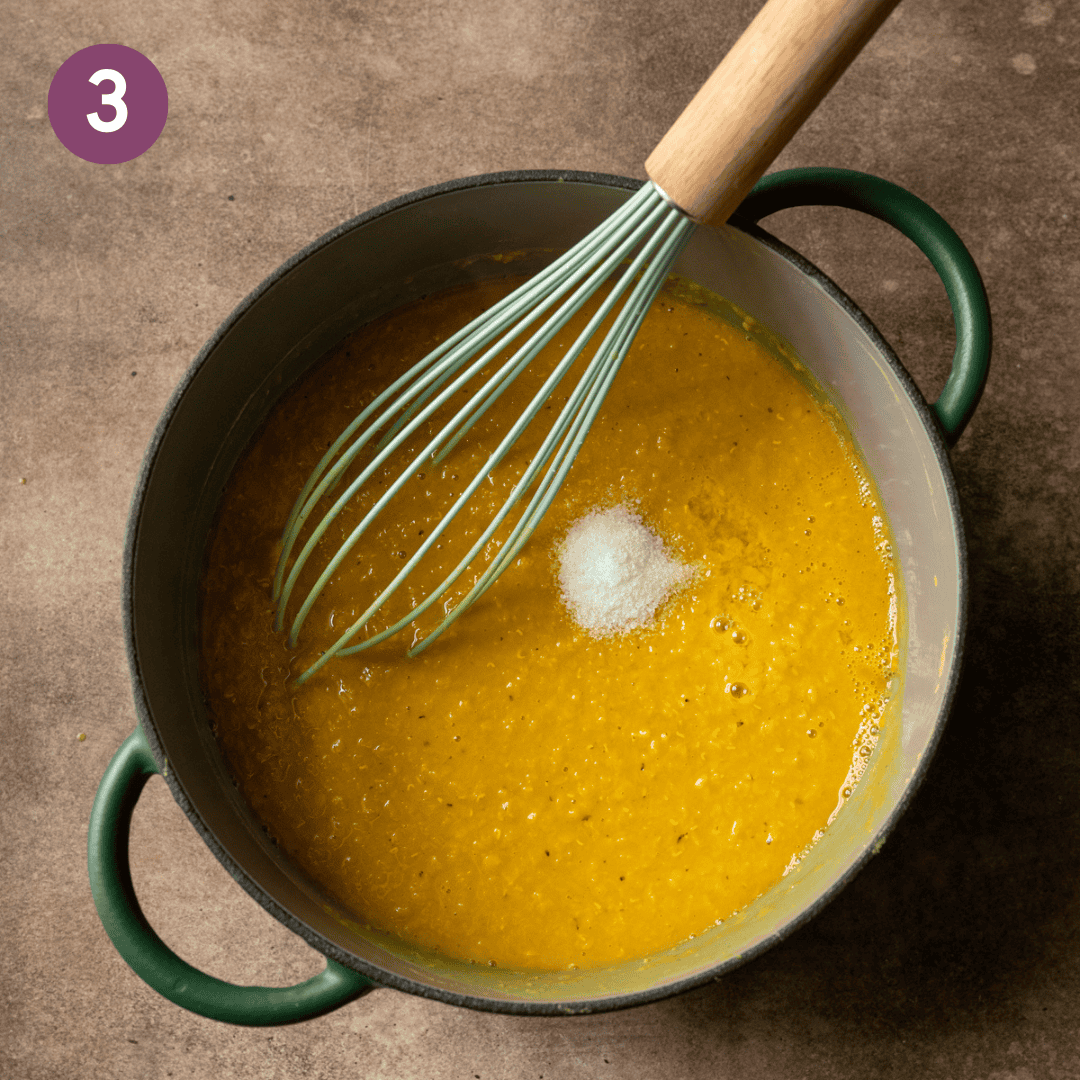
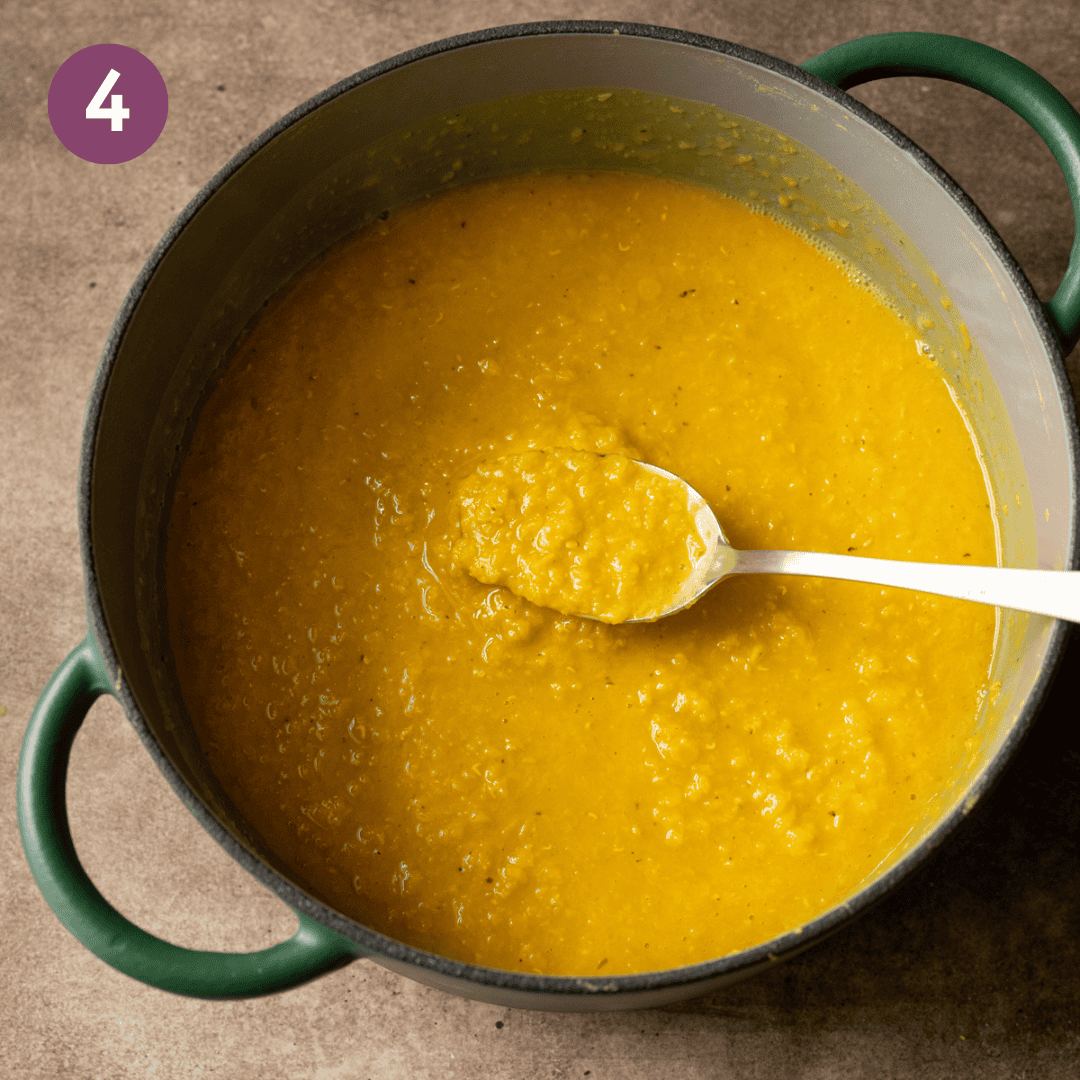
While the dal cooks, prep your Spinach Tadka ingredients.
Heat a large sauté pan over medium-high heat with the oil. Toast the cumin seeds and mustard seeds until the mustard seed pop and the cumin seeds turn darker brown.
Add in the onions; reduce the heat to medium. Cook until golden brown, stirring occasionally.
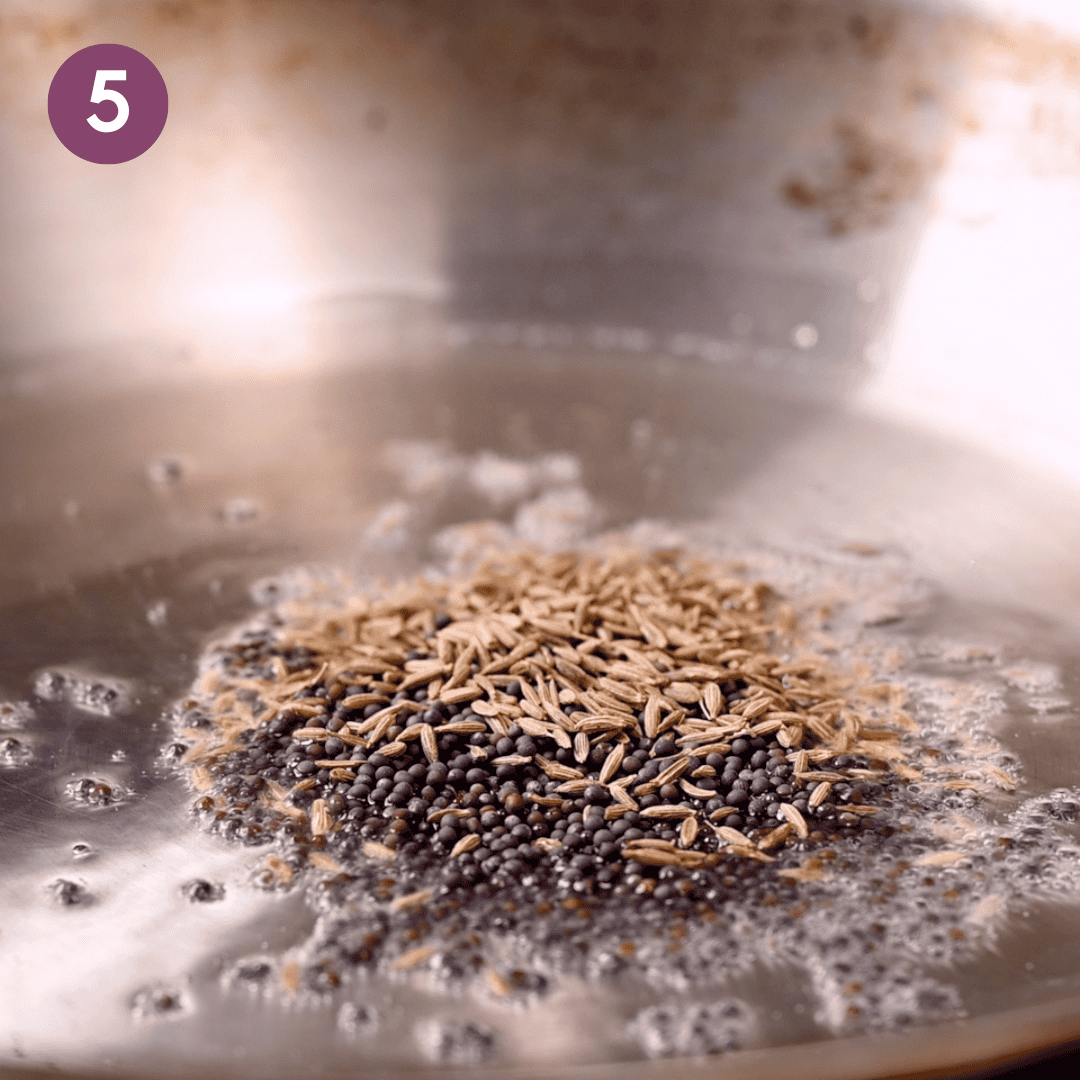
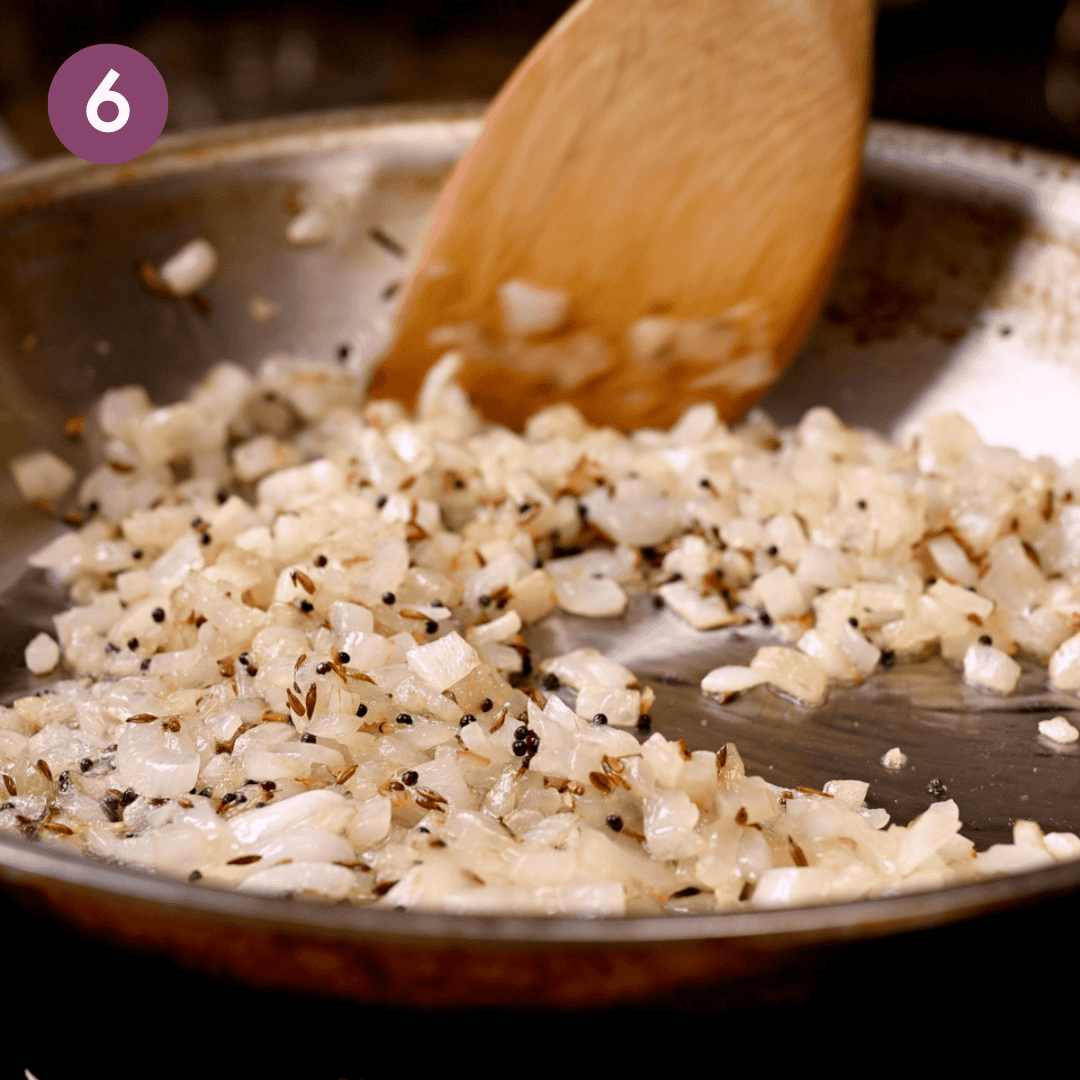
Add in the garlic, ginger, and fresh green chile peppers. Stir for 1 to 2 minutes.
Add the dried red chile peppers, curry leaves, and asafoetida. Stir for 30 seconds.
Finally, add in the baby spinach in batches, seasoning with a bit of salt. Use tongs to stir; cook until just wilted.
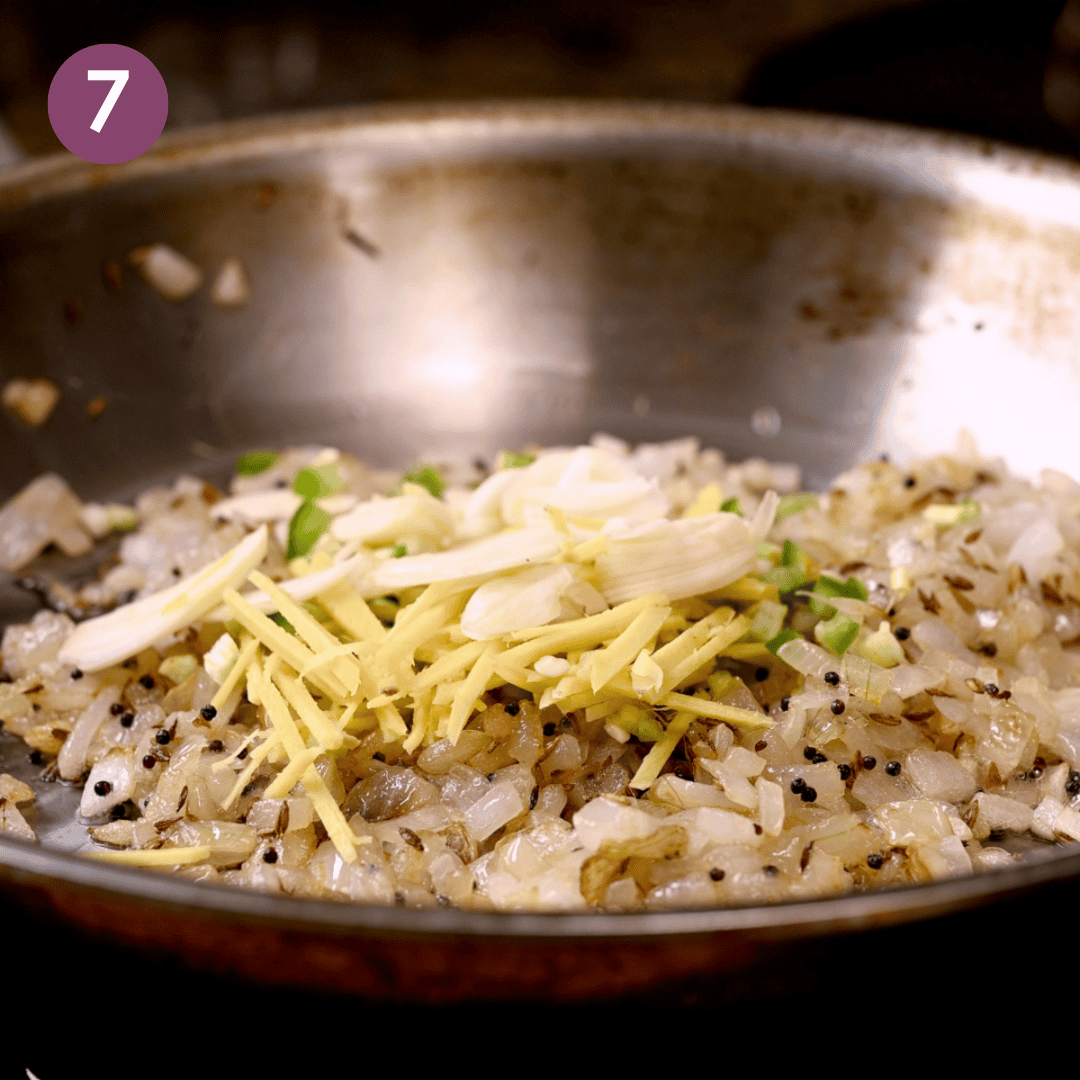
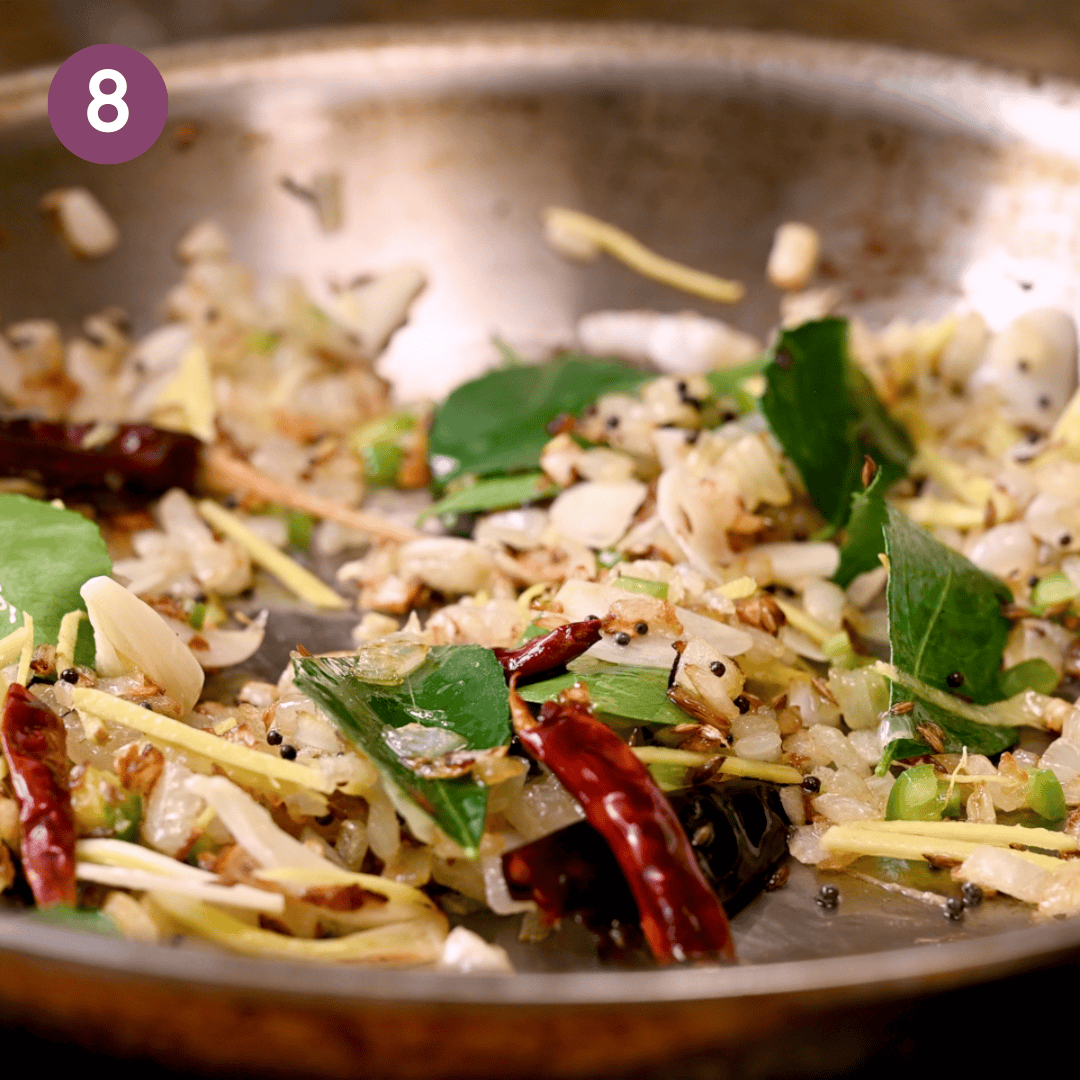

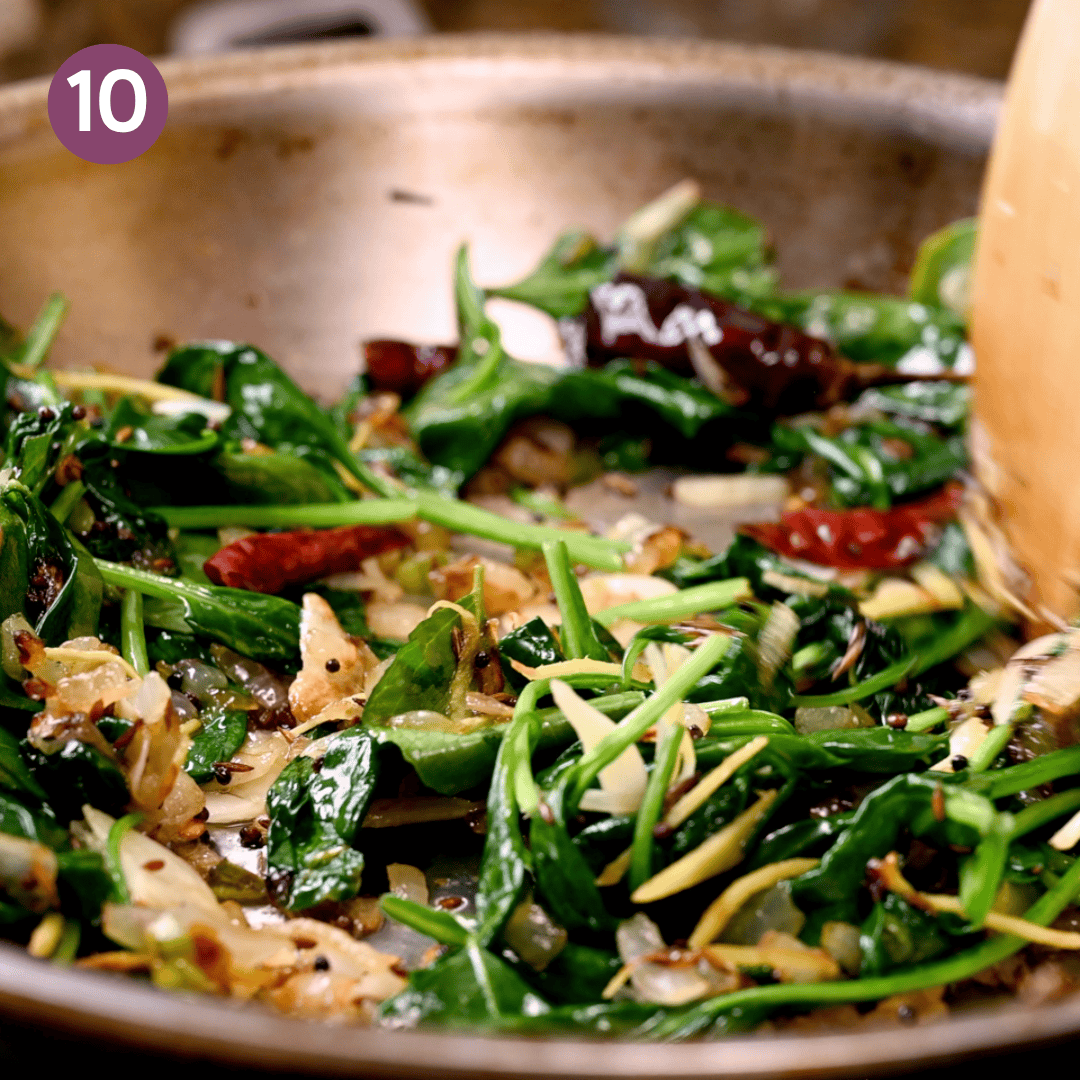
Pour the spinach tadka on top of the dal; garnish with cilantro.
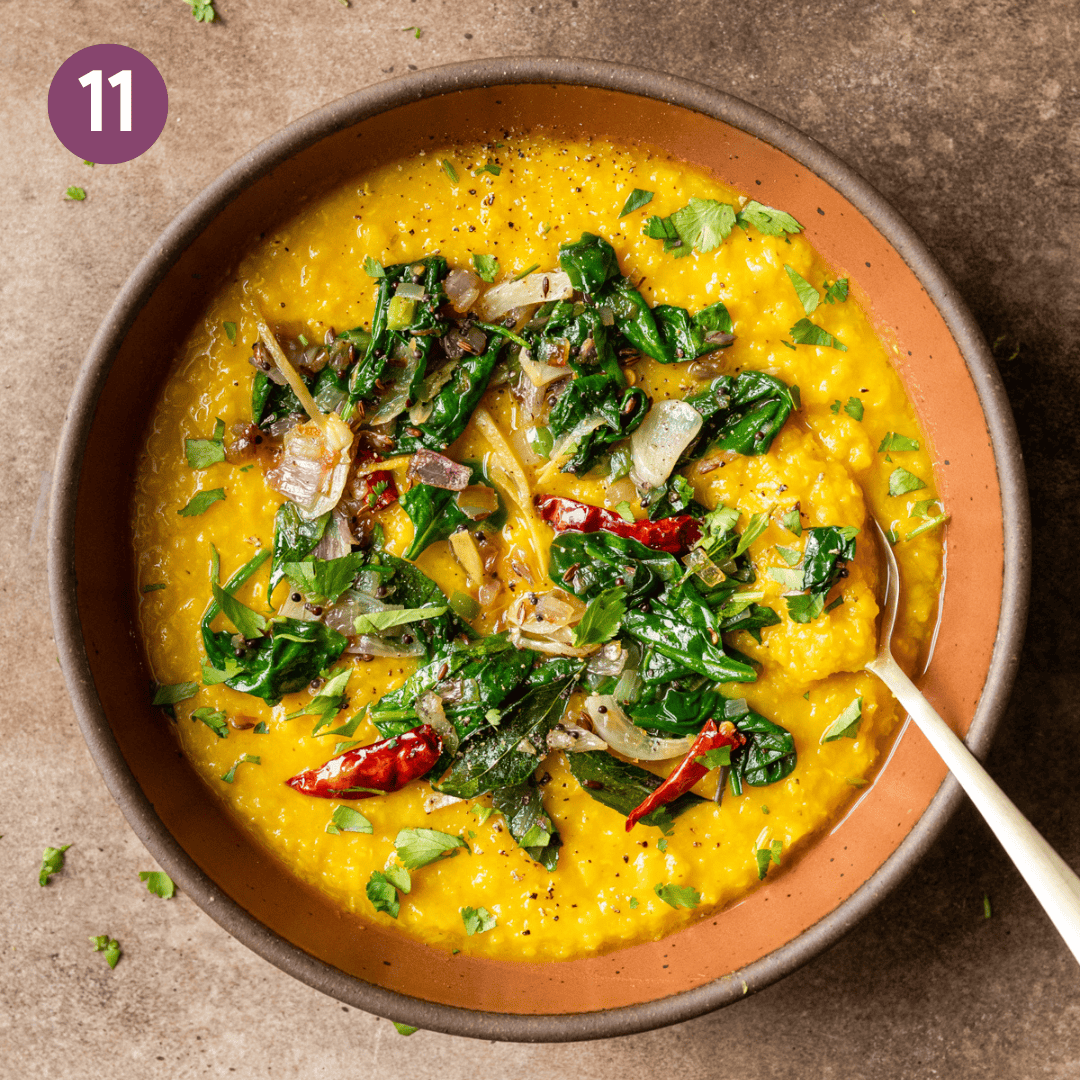
The beauty of a tadka is that you can get creative. While I stand by my choices of whole spices, fresh curry leaves, and aromatics, go ahead and mix things up (and tell me how it goes for you in the comments!).
Some fun ideas for your consideration:
The spices in a tadka can burn very easily. Once they’re sizzling in the pan, don’t stop stirring or shaking the pan.
Let’s be honest: After a typical workday, the energy’s just not always there to make a whole meal completely from scratch. But what if you only had to do a fraction of the work to get the same delicious dinners on the table? Ah, the magic of Sunday meal prep.
With Meal Plans by Rainbow Plant Life, you’ll learn how to spend 60 to 90 minutes on Sunday preparing components for three fabulous weeknight dinners, including this Dal Palak.
When dal palak night rolls around, this meal will come together even quicker and with less fuss. It’s all the flavor you want with none of the extra weeknight effort.
Every week, you’ll get three hearty, comforting meals and a side (this dal palak will be featured in a meal plan in June) as well as a full grocery list (with a sister list broken down by recipe), handy substitutions, and emergency meal ideas for nights when you just don’t have the time. No more scrounging the internet for far too long to find new and exciting dinner recipes or scrambling to build a whole grocery list. Instead, you’ll make weeknights fun again.
Try it out with a 7-day free trial!
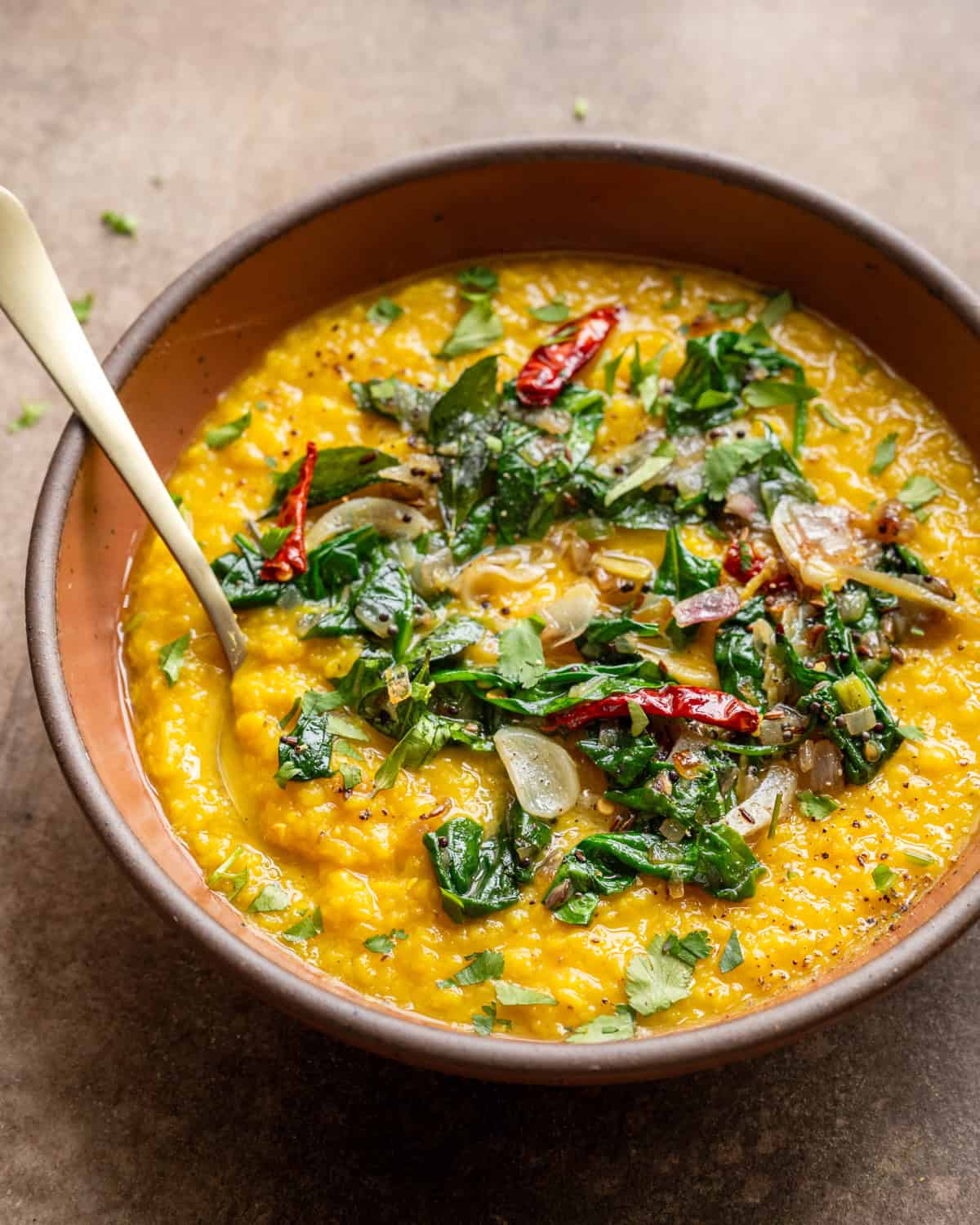
Dal is typically made from split lentils or split peas, although other recipes use split chickpeas (chana dal) or kidney beans (rajma dal). For this recipe, I recommend sticking with red split lentils (masoor dal), yellow split lentils (moong dal), or even yellow split pigeon peas (toor dal) if you have them on hand (affiliate links). The cook time will vary slightly depending on which one you choose.
And of course, you can always use regular red lentils, sold at most grocery stores (they take just a bit longer to cook and soften).
Soaking your lentils in cold water for 15 to 20 minutes before cooking can help them cook quicker, but it’s not necessary. Part of why I love this recipe is that the lentils cook so quickly even without soaking! If you do soak them, though, cook the lentils in fresh water, not their soaking water.
You can certainly make the dal itself ahead of time. Once it cools down a bit, store it in a container in the fridge for 3 to 4 days, and reheat on the stove, stirring occasionally. The tadka is best made fresh if you have the time. If you meal prep the dal, then this dish will come together in less than 30 minutes!
The most traditional (and easiest) way is to serve the dal palak over cooked white rice. But you can also scoop up each bite with an Indian flatbread like my homemade Vegan Naan (easier than it sounds!) or even store-bought vegan naan or good-quality fluffy pita. A scoop of plain vegan yogurt or homemade Vegan Raita adds a super cozy cooling touch too.
Oh yes. Dal palak is Monopoly-Man-rich in protein, fiber, vitamins, minerals, and antioxidants thanks to the lentils, spinach, and the superfood turmeric in the dal. Plus, garlic, ginger, green chiles, and curry leaves are all rich in antioxidants. So yes, it’s absolutely great for you, and it tastes absolutely great too.
After the leftover dal and tadka have cooled to room temperature, store them together in an airtight container. They’ll stay fresh in the fridge for up to 3 days. Dal also freezes well for up to 6 months, though the texture of the tadka is best fresh.
Let the leftovers thaw in the fridge overnight before reheating in the microwave or a saucepan on the stove. Going the stove route? Stir the dal semi-frequently so it doesn’t burn.
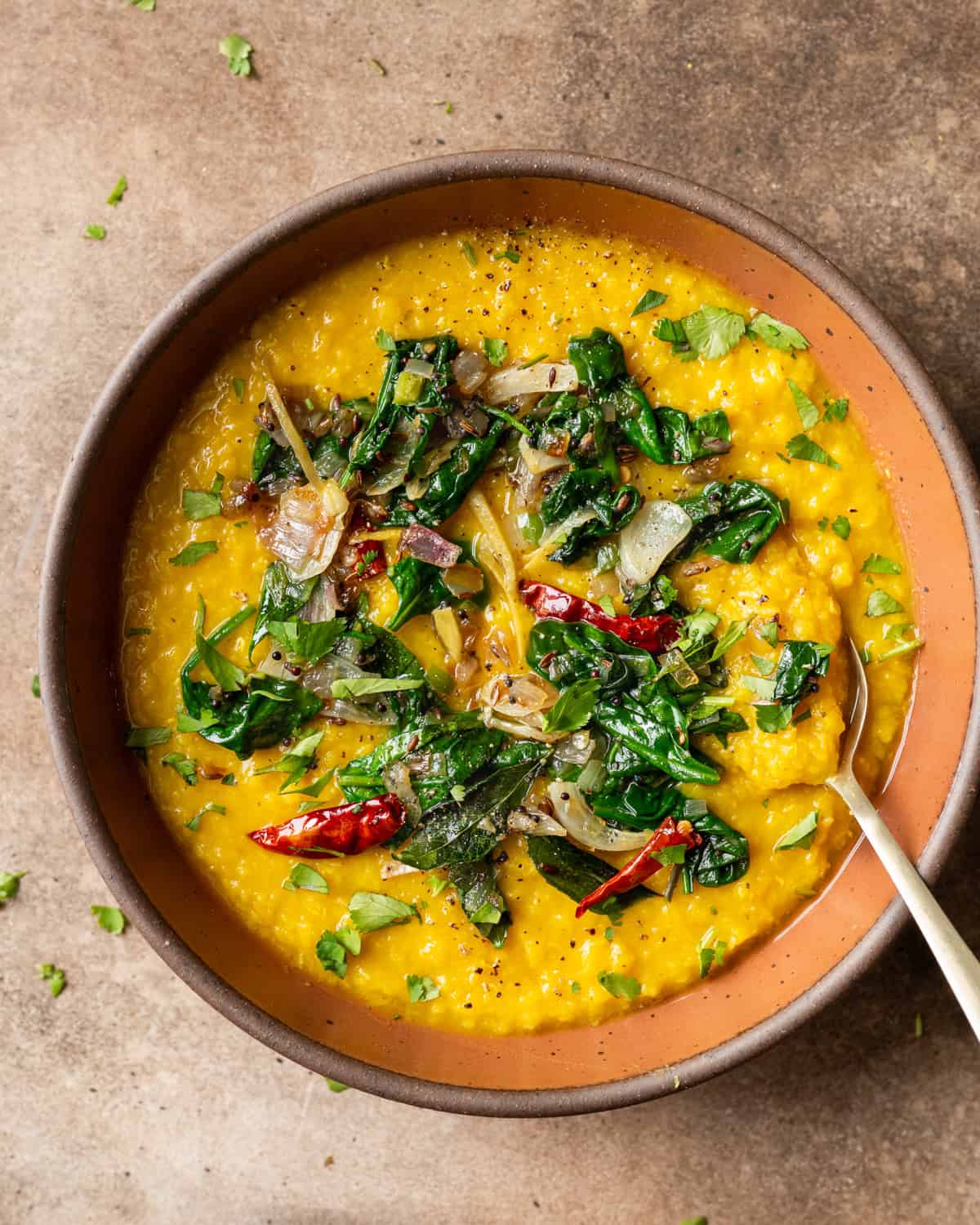
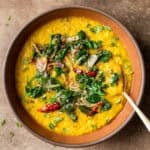
The post Dal Palak appeared first on Rainbow Plant Life.
Image by Ulrike Leone from Pixabay
Proton prioritizes our community’s privacy and data security in every aspect of our business.
To further demonstrate our commitment, we underwent a rigorous external audit and – on May 2, 2024 – received our ISO 27001 certification.
As an organization founded by scientists who met at CERN, we see peer review and transparency as a cornerstone of our mission. That’s why we make all our apps open source, allowing anyone to examine our code.
Here’s what this latest certification means and what’s next for Proton.
At Proton, our philosophy is to focus first on good security and let compliance with standards and frameworks follow.
Our philosophy was confirmed by the fact that, to comply with ISO 27001:2022, we only needed to formalize and document some of our current processes. No fundamental changes in how our business or teams operate were required.
This comprehensive audit spanned 14 days and involved over 15 dedicated teams, each thoroughly evaluating the information security management systems underlying all Proton products.
Basically, our security management operations were double-checked and validated by independent experts.
At Proton, we believe in building products our community can trust. We also believe that trust must be earned. As an organization founded and run by former scientists, we believe all claims must be not only investigated but verified, including our own
Transparency and peer review are the best ways to ensure systems function as they’re supposed to and vulnerabilities are quickly resolved. This approach only becomes more important as we grow and add new services. This certification not only proves our methodology is sound, it makes it easier for us to work with larger organizations in the future.
We pursued this certification for the same reason we open our products to scrutiny through external penetration tests and our bug bounty program: To ensure any vulnerabilities in our service are swiftly identified and resolved so your information remains safe.
Looking ahead, we plan to strengthen support for our business customers, particularly those handling sensitive data, by publishing further information and audit reports detailing our security controls.
Thank you for being part of our mission to build a better internet where privacy is the default. Stay tuned for more updates and new features designed to keep your data safe and secure.